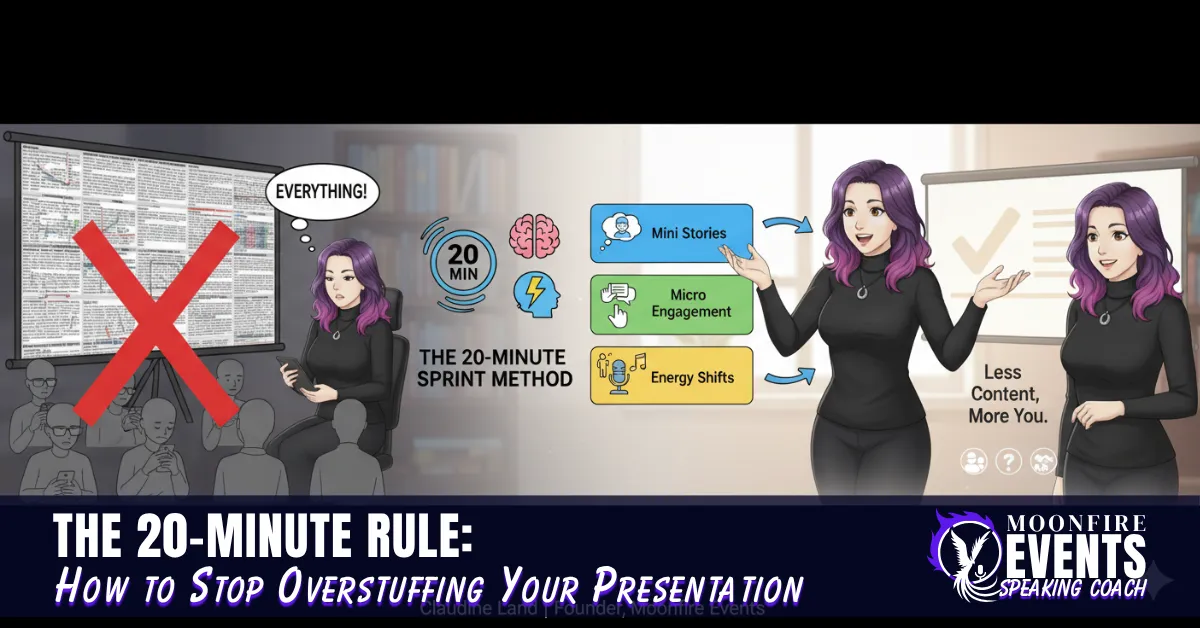
The 20-Minute Rule: How to Stop Overstuffing Your Presentation
The 20-Minute Rule: How to Stop Overstuffing Your Presentation
You're Doing It Again
You're doing it again. Cramming your entire brilliant brain into 45 minutes, white-knuckling through slides you know are too dense, watching eyes glaze over while you're mid-sentence about the methodology nobody asked for.
You pile in all the research, all the details, all the tangents, all the "must-know" background - because what if you leave something out? What if they think you don't know enough? What if simplifying makes you look less credible?
So you keep going. Slide after slide. Point after point. Until you look up and your audience looks like they just survived a turkey dinner - glazed, heavy-lidded, silently begging for a nap.
Here's the outlaw truth: you're not boring. You're just overstuffing.
And there's a natural rhythm you're fighting against: the 20-minute rule.
Your Brain Already Knows This
If you've ever found yourself zoning out during a webinar, checking your phone mid-presentation, or mentally planning dinner while someone's still talking - your brain was doing exactly what it's designed to do.
Attention isn't linear. It's tidal. It moves in waves. Peaks and dips. Energy spikes, followed by resets.
For neurodivergent brains especially, working memory is precious real estate - and you can't pack a mansion worth of furniture into a studio apartment. Science backs this up: most humans start drifting around the 15-20 minute mark. For ADHD brains? That window can be even shorter. Our attention operates in sprints, not marathons.
When you ignore this rhythm, you overload your audience with information they can't process - and overload yourself trying to deliver it.
But here's what nobody tells you: this isn't a weakness. It's design specs.
When you honor the 20-minute cycle, you're not dumbing things down. You're designing for how brains actually work. You're working with your neurology instead of trying to perform your way past it.
The Real Cost of "Proving" Yourself
Let's name the actual fear driving this overstuffing habit:
"If I don't prove I know EVERYTHING, they'll see I'm faking it."
"If I simplify, they'll think I'm not smart enough."
"I need to justify taking up space in this room."
So you perform competence through exhaustion. You turn yourself into a walking Wikipedia entry, cramming in every credential, every case study, every piece of supporting evidence - as if volume equals value.
It doesn't.
Packing in everything you know doesn't prove expertise. It proves you don't trust yourself (or your audience) enough to simplify. And it's costing you more than you realize.
The real costs of ignoring natural attention cycles:
Info-dump delivery. You talk non-stop, racing through content, and your audience retains maybe 10%. They leave feeling overwhelmed, not educated. Confusion doesn't convert.
Disengaged attendees. People check out. They check phones. They zone into daydreams about their grocery list. You've lost them by minute 25, but you're still delivering content for another 20 minutes to an empty room.
Scattered energy. You burn yourself out trying to sprint a marathon. You finish presentations feeling wrung out, wondering why no one had questions, why the chat was dead, why nobody booked a call.
Missed business opportunities. Here's the part that really stings: every overstuffed presentation is a missed conversion opportunity. When your audience leaves overwhelmed, they don't buy. They don't book calls. They don't remember you. They just feel tired.
But when you chunk and reset? They lean in. They engage. They ask questions. They come back for more.
Your audience doesn't need everything at once. They need clarity in chunks. They need space to process. They need to feel something instead of knowing everything.
The 20-Minute Sprint Method
Instead of one endless content stream that leaves everyone gasping for air, structure your presentations in 20-minute sprints with built-in resets.
Think of your presentation like a playlist, not a lecture. Each "song" (content block) runs about 15-20 minutes. Between tracks, you create a pattern interrupt - something that jolts attention back online before diving into the next section.
Here's what this actually looks like in practice:
Before: The Overstuffed Approach
❌ 8 dense slides covering theory, research background, methodology, three case studies, implementation framework, potential objections, and a resource list - delivered in 40 minutes of continuous talking with "questions at the end."
Result: Glazed eyes by minute 18. Zero questions because everyone's brain is full. No follow-up conversations.
After: The Chunked Approach
✅ 3 focused points, each taking 15-18 minutes:
Point 1: The core problem (with one vivid story)
Reset: Quick poll - "Which of these sounds most familiar?"
Point 2: The solution framework (your methodology, simplified)
Reset: 60-second turn-and-talk or chat prompt
Point 3: What this looks like in practice (one detailed example)
Reset: Live Q&A as you go, not saved for the end
Result: Engaged audience. Active chat. People who actually remember your three points and can explain them to someone else.
Your ND-Friendly Reset Toolkit
These aren't gimmicks. They're attention anchors. Every time you hit that 15-20 minute mark, drop an anchor to pull everyone back in.
1. Mini Stories (60-90 seconds max)
Drop a quick anecdote, client example, or personal moment that illustrates your point. Not a five-minute tangent - a tight, vivid snapshot.
Example: "Last month a client told me she'd been rehearsing the same presentation for three weeks and kept adding slides. By the time we talked, she had 47 slides for a 30-minute talk. Her hands were shaking just thinking about it. We cut it to 12 slides. She delivered it in 25 minutes. Got three client inquiries that week."
Why it works: Stories activate different parts of the brain than data does. They give your audience's analytical mind a break while keeping them engaged.
2. Micro Engagement (30 seconds)
Create tiny moments of interaction. You're not trying to facilitate a deep discussion - you're creating a quick pattern interrupt.
Examples that actually work:
"Drop a ⚡ in the chat if you've ever rehearsed by cramming MORE in"
"Type ONE WORD that describes how you feel before a big presentation"
"Quick poll: How many slides are in your current presentation deck? A) Under 10, B) 10-20, C) I'm scared to count"
Why it works: The act of responding - even with an emoji - reactivates attention. It shifts people from passive receiving to active participation.
3. Energy Shifts (physical and vocal)
Change something about your delivery. Your brain registers novelty as "pay attention to this."
Physical shifts:
Stand up if you've been sitting
Move to a different spot in your space
Change your camera angle
Pick up an object and gesture with it
Vocal shifts:
Drop your voice to almost a whisper for your next sentence
Speed up deliberately for 15 seconds, then slow way down
Pause for a full 3-count of silence (it feels eternal to you; it feels dramatic to them)
Ask a question and actually wait for someone to answer
Why it works: Novelty = attention. When you shift the sensory input, you interrupt the drift into zone-out territory.
What You're Really Cutting
When you commit to the 20-minute rule, you're not cutting value. You're cutting performance anxiety disguised as content.
Here's what actually gets trimmed:
The "just in case" slides. The ones you included because you're worried someone might ask about that one thing, even though it's not central to your message.
The credibility padding. All the background context and research citations you're using as armor to prove you belong in the room.
The tangent insurance. The extra examples and side points you've stockpiled in case you freeze up or run out of things to say.
The everything bagel approach. The desperate need to address every possible angle, objection, or audience member's specific situation in one sitting.
What stays is the good stuff: your core message, your unique insight, your authentic energy, and the space for your audience to actually process what you're saying.
Stop Performing Your Anxiety
Here's your permission slip, delivered with a shove: Stop performing competence through exhaustion.
You're not a walking Wikipedia, and pretending to be one is making you - and everyone watching - miserable.
Cut 30% of your slides. I'm serious. Open that deck right now and delete a third of it. If you're hyperventilating at the thought, you're proving my point.
Let silence stretch instead of stuffing it with more words. Give your audience fewer points, delivered with more energy and story. Trust that they'd rather understand three things deeply than skim the surface of fifteen.
Your credibility doesn't come from how much you cram in. It comes from how clearly you connect. It comes from the moment someone says, "Oh, I never thought about it that way," not "Wow, she really knows a lot."
Rebel moves for your next presentation:
Delete the first three slides. They're probably throat-clearing. Start where it gets interesting.
Cut every slide that exists to prove you did your homework. Your audience trusts you or they wouldn't be there.
Replace one content section with a story. Just one. See what happens.
End ten minutes early. Use that time for real conversation, not rushed Q&A while people are already logging off.
Practice saying less. Not speaking faster to fit it all in - actually saying less and letting it breathe.
The next time you're building a presentation, ask yourself: Am I serving my audience, or am I performing my anxiety?
One builds connection. The other builds resentment.
Choose.
The Rule We're Burning
The old rule: Pack everything in to prove you know it. More slides = more credibility. If you're not exhausted at the end, you didn't work hard enough.
The new rule: Honor the 20-minute rhythm. Chunk your content into digestible sprints. Reset attention intentionally. Trust that less delivered with clarity and energy will always beat more delivered with desperation.
Your audience will thank you - not with polite applause, but with engagement, questions, conversations, and client inquiries.
Because the goal isn't to prove you know everything. The goal is to create the space for them to feel something, learn something, and want more of whatever you're offering.
You don't need to dump your whole brain into every presentation. You just need to be clear, connected, and brave enough to let go of the rest.
Your next presentation doesn't need more content.
It needs more you, and less performance.
Ready to design presentations that keep your audience awake and craving more?
Stop overstuffing. Start connecting.
Claudine Land The Virtual Event Whisperer | Founder, MoonFire Events
Where "too much" becomes your greatest business asset
Core Questions
Q: Why do audiences zone out during long presentations?
A: Because attention runs in cycles of 15–20 minutes. After that, focus dips. Overstuffing slides ignores this rhythm and leaves audiences overwhelmed and disengaged.
Q: What is the 20-minute rule in presentations?
A: The 20-minute rule says that attention naturally wanes after about 20 minutes. To keep engagement alive, presenters should chunk content into sprints and add resets like stories, polls, or energy shifts.
Q: Why do ND (neurodivergent) audiences lose focus faster?
A: ADHD and ND brains operate in shorter attention sprints. Working memory gets overloaded quickly, so dense, continuous content leads to zoning out. Resets honor how ND brains process information.
Q: How can I stop overstuffing my presentations?
A: Use the 20-Minute Sprint Method:
Focus on 3 main points.
Add resets every 15–20 minutes (stories, polls, movement).
Cut 30% of slides - especially the “just in case” filler.
Q: Does simplifying content make me look less credible?
A: No. Overstuffing is actually performance anxiety disguised as content. Credibility comes from clarity, presence, and connection - not cramming every detail.
Q: What’s the cost of ignoring the 20-minute rule?
A: Info-dump delivery, disengaged audiences, burnout for the speaker, and missed business opportunities. Overwhelmed audiences don’t convert - they forget.



